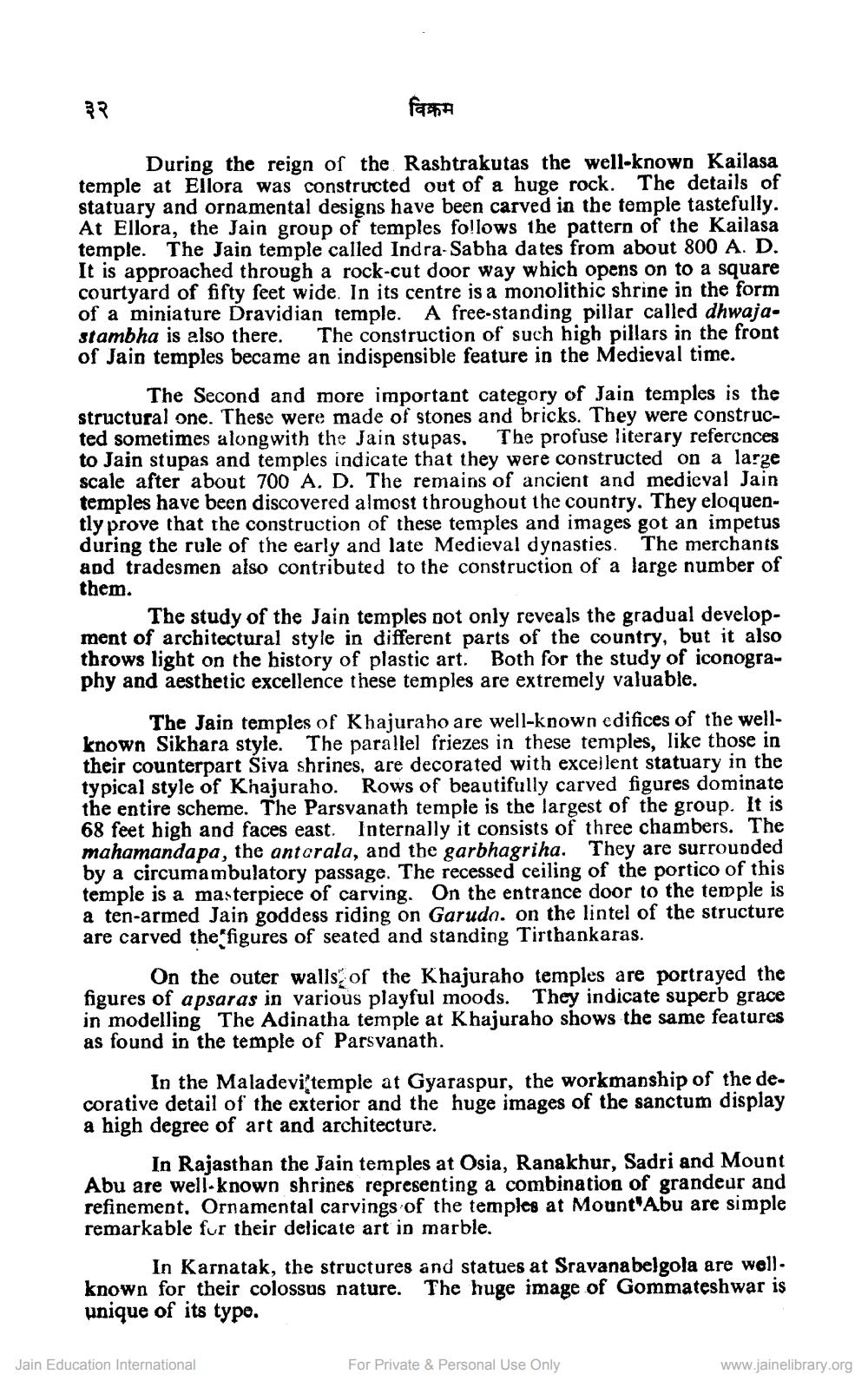________________
विक्रम
During the reign of the Rashtrakutas the well-knowo Kailasa temple at Ellora was constructed out of a huge rock. The details of statuary and ornamental designs have been carved in the temple tastefully. At Ellora, the Jain group of temples follows the pattern of the Kailasa temple. The Jain temple called Indra-Sabha dates from about 800 A. D. It is approached through a rock-cut door way which opens on to a square courtyard of fifty feet wide. In its centre is a monolithic shrine in the form of a miniature Dravidian temple. A free-standing pillar called dhwaja. stambha is also there. The construction of such high pillars in the front of Jain temples became an indispensible feature in the Medieval time.
The Second and more important category of Jain temples is the structural one. These were made of stones and bricks. They were constructed sometimes along with the Jain stupas. The profuse literary refercnces to Jain stupas and temples indicate that they were constructed on a large scale after about 700 A. D. The remains of ancient and medieval Jain temples have been discovered almost throughout the country. They eloquently prove that the construction of these temples and images got an impetus during the rule of the early and late Medieval dynasties. The merchants and tradesmen also contributed to the construction of a large number of them.
The study of the Jain temples pot only reveals the gradual development of architectural style in different parts of the country, but it also throws light on the history of plastic art. Both for the study of iconography and aesthetic excellence these temples are extremely valuable.
The Jain temples of Khajuraho are well-known edifices of the wellknown Sikhara style. The parallel friezes in these temples, like those in their counterpart Siva shrines, are decorated with excellent statuary in the typical style of Khajuraho. Rows of beautifully carved figures dominate the entire scheme. The Parsvanath temple is the largest of the group. It is 68 feet high and faces east. Internally it consists of three chambers. The mahamanda pa, the antarala, and the garbhagriha. They are surrounded by a circumambulatory passage. The recessed ceiling of the portico of this temple is a masterpiece of carving. On the entrance door to the temple is a ten-armed Jain goddess riding on Garuda. on the lintel of the structure are carved the figures of seated and standing Tirthankaras.
On the outer walls of the Khajuraho temples are portrayed the figures of apsaras in various playful moods. They indicate superb grace in modelling The Adinatha temple at Khajuraho shows the same features as found in the temple of Parsvanath.
In the Maladevi temple at Gyaraspur, the workmanship of the decorative detail of the exterior and the huge images of the sanctum display a high degree of art and architecture.
In Rajasthan the Jain temples at Osia, Ranakhur, Sadri and Mount Abu are well-known shrines representing a combination of grandeur and refinement, Ornamental carvings of the temples at Mount'Abu are simple remarkable fur their delicate art in marble.
In Karnatak, the structures and statues at Sravanabelgola are wellknown for their colossus nature. The huge image of Gommateshwar is unique of its type.
Jain Education International
For Private & Personal Use Only
www.jainelibrary.org




